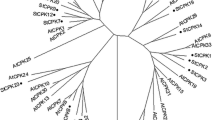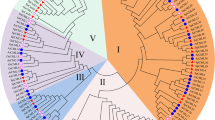Abstract
Eight genomic clones of potato calmodulin (PCM1 to 8) were isolated and characterized. Sequence comparisons of different genes revealed that the deduced amino acid sequence of PCM1 had several unique substitutions, especially in the fourth Ca2+-binding area. The expression patterns of different genes were studied by northern analysis using the 3′-untranslated regions as probes. The expression of PCM1, 5, and 8 was highest in the stolon tip and it decreased during tuber development. The expression of PCM6 did not vary much in the tissues tested, except in the leaves, where the expression was lower; whereas, the expression of PCM4 was very low in all the tissues. The expression of PCM2 and PCM3 was not detected in any of the tissues tested. Among these genes, only PCM1 showed increased expression following touch stimulation. To study the regulation of PCM1, transgenic potato plants carrying the PCM1 promoter fused to the β-glucuronidase (GUS) reporter gene were produced. GUS expression was found to be developmentally regulated and touch-responsive, indicating a positive correlation between the expression of PCM1 and GUS mRNAs. These results suggest that the 5′-flanking region of PCM1 controls developmental and touch-induced expression. X-Gluc staining patterns revealed that GUS localization is high in meristematic tissues such as the stem apex, stolon tip, and vascular regions.
Similar content being viewed by others
References
Balamani V, Veluthambi K, Poovaiah BW: Effect of calcium on tuberization in potato (Solanum tuberosom L.). Plant Physiol 80: 856–858 (1986).
Botella JR, Arteca RN: Differential expression of two calmodulin genes in response to physical and chemical stimuli. Plant Mol Biol 24: 757–766 (1994).
Braam J, Davis RW: Rain-, wind-, and touch-induced expression of calmodulin and calmodulin-related genes in Arabidopsis. Cell 60: 357–364 (1990).
Braam J: Regulated expression of the calmodulin-related TCH genes in cultured Arabidopsis cells: induction by calcium and heat shock. Proc Natl Acad Sci USA 89: 3213–3216 (1992).
Dauwalder M, Roux SJ, Hardison L: Distribution of calmodulin in pea seedlings: immunocytochemical localization in plumules root apeces. Planta 168: 461–470 (1986).
Gawienowski MC, Szymanski D, Perera IY, Zielinski RE: Calmodulin isoforms in Arabidopsis encoded by multiple divergent mRNAs. Plant Mol Biol 22: 215–225 (1993).
Jefferson RA, Kavanagh TA, Bevan MW: GUS fusions: β-glucuronidase as a sensitive and versatile gene fusion marker in higher plants. EMBO J 6: 3901–3907 (1987).
Jena PK, Reddy ASN, Poovaiah BW: Molecular cloning and sequencing of a cDNA for plant calmodulin: signal-induced changes in the expression of calmodulin. Proc Natl Acad Sci USA 86: 3644–3648 (1989).
Klee CB, Crouch TH, Richman PG: Calmodulin. Ann Rev Biochem 49: 489–515 (1980).
Knight MR, Smith SM, Trewavas AJ: Wound-induced plant motion immediately increases cytosolic calcium. Proc Natl Acad Sci USA 89: 4967–4971 (1992).
Knight MR, Campbell AK, Smith SM, Trewavas AJ: Transgenic plant aequorin reports the effects of touch and cold-shock and elicitors on cytoplasmic calcium. Nature 352: 524–526 (1991).
Ling V, Zielinski RE: Cloning of cDNA sequences encoding the calcium-binding protein, calmodulin, from barley (Hordeum vulgare L.). Plant Physiol 90: 714–719 (1989).
Ling V, Perera I, Zielinski RE: Primary structures of Arabidopsis calmodulin isoforms deduced from the sequences of cDNA clones. Plant Physiol 96: 1196–1202 (1991).
Perera IY, Zielinski RE: Structure and expression of the Arabidopsis CaM-3 calmodulin gene. Plant Mol Biol 19: 649–664 (1992).
Perera I, Zielinski RE: Synthesis and accumulation of calmodulin in suspension cultures of carrot (Daucus carota L.): evidence for post-transcriptional control of calmodulin expression. Plant Physiol 100: 812–819 (1992).
Poovaiah BW, Reddy ASN: Calcium messenger system in plants. CRC Crit Rev Plant Sci 6: 47–103 (1987).
Poovaiah BW, Reddy ASN, An G, Choi YJ and Wang ZQ: Calmodulin gene expression and Ca2+/calmodulin-dependent protein kinase II in plants. In: Karrssen CM, vanLoon LC, Vreugdenhil D (eds) Progress in Plant Growth Regulation, pp. 691–702. Kluwer Academic Publishers. London (1992).
Poovaiah BW, Reddy ASN: Calcium and signal transduction in plants. CRC Crit Rev Plant Sci 12: 185–211 (1993).
Poovaiah BW, Takezawa D, An G, Han TJ: Potato plants carrying sense and antisense constructs of calmodulin exhibit striking differences in growth and development. Plant Physiol Suppl 102: 13 (1993).
Putkey JA, Ts'us KF, Tanaka T, Lagace L, Stein JP, Lai EC, Means AR: Chicken calmodulin genes: a species comparison of cDNA sequences and isolation of a genomic clone. J Biol Chem 258: 11864–11870 (1983).
Roberts DM, Lukas TJ, Watterson DM: Structure, function, and mechanism of action of calmodulin. CRC Crit Rev Plant Sci 4: 311–339 (1986).
Roberts DM, Harmon AC: Calcium-modulated proteins: targets of intracellular calcium signals in higher plants. Annu Rev Plant Physiol Plant Mol Biol 43: 375–414 (1992).
Roesler WJ, Vandenbark GR, Hanson RW: Cyclic AMP and the induction of eukaryotic gene transcription. J Biol Chem 263: 9063–9066 (1988).
Sambrook J, Fritsch EF, Maniatis T: Molecular Cloning, A Laboratory Manual, 2nd ed. Cold Spring Harbor Laboratory Press, Cold Spring Harbor, NY (1989).
Verwoerd TC, Dekker BMM, Hoekema A: A small-scale procedure for the rapid isolation of plant RNAs. Nucl Acids Res 17: 2362 (1989).
Watillon B, Kettmann R, Boxus P, Burny A: Cloning and characterization of an apple (Malus domestica [L.] Borkh) calmodulin gene. Plant Sci 82: 201–212 (1992).
Wenzler H, Mignery G, May G, Park W: A rapid and efficient transformation method for the production of large numbers of transgenic potato plants. Plant Sci 63: 79–85 (1989).
Zielinski RE: Calmodulin mRNA in barley (Hordeum vulgare L.). Apparent regulation by cell proliferation and light. Plant Physiol 84: 937–943 (1987).
Author information
Authors and Affiliations
Additional information
Laboratory of Plant Molecular Biology and Physiology Department of Horticulture correspondence
Rights and permissions
About this article
Cite this article
Takezawa, D., Liu, Z.H., An, G. et al. Calmodulin gene family in potato: developmental and touch-induced expression of the mRNA encoding a novel isoform. Plant Mol Biol 27, 693–703 (1995). https://doi.org/10.1007/BF00020223
Received:
Accepted:
Issue Date:
DOI: https://doi.org/10.1007/BF00020223




